My friend Hardy Ruf is a big proponent of early-season pike fishing. As the owner and operator of Dalton Trail Lodge in the Yukon, he’s always suggested that I visit in early June, just to see how good the pike fishing can be.
“The earlier the better,” he says. “For pike, you can’t go too early.”
And, generally speaking, he’s right. Northern pike start to seek out warmer waters in boreal lakes just after ice out. In shallows, they’ll find both food and the right temperatures to bring them out of their winter doldrums.
But there are instances where the big predators can be hard to find, particularly on large bodies of water that take some time to warm up enough to bring both the pre-spawn males and the bigger, egg-laden females into shallow water. Often, the best scenario for fly fishers is to find shallow water, where the pike will eventually gather, and then look for structure and slightly deeper water, like abrupt drop-offs, shoals or froggy creek mouths where running water has carved deeper channels.
Earlier this week, I had the unique chance to fish the waters of Aishihik Lake in the southern Yukon for both inshore lake trout and toothy northern pike. The lake is seriously big — some 80 kilometers from one end to the other. And, because of prevailing winds, the north end of the lake is free of ice first, and it’s also the area of the lake that warms up fastest.
More Like This
Pike are spring spawners, and the smaller and more eager males are the first to arrive in shallow water. The bigger females — any trophy pike over 40 inches in length is almost certainly a female — come in shortly after the males.
But, during that pre-spawn period where the males are in and waiting for their prospective mates, a few factors come into play. Water temperature is always a consideration, as is the available prey base. As we hunted the inshore lagoons and shallow shoals of Aishihik this week, we got a lesson in Pike 101.
Look for pike food
In lakes like Aishihik (pronounced AY-Shack), a pike’s prey base is varied. The opportunistic predators will eat damn near anything, from Arctic grayling and lake whitefish to baby lake trout and, yes, even other pike.
As we motored around the north end of the lake, we entered a bay that features a gradual gravel beach that offers protection from the near-constant wind, and an abrupt drop-off about 20 feet from the shore. And, because of the protection from the wind, the bay is also where the lake’s whitefish congregate to munch on blanket hatches of midges —– the dimples and rise rings we saw as we entered the bay got our guide, Allen, pretty excited.
“They’re going to be here,” he said.
He beached the boat and we climbed out and started tossing typical pike patterns — eight-inch-long streamers that pulsed in the water with every pause. As we watched the whitefish lazily sipping clusters of midges, we started to get a few grabs from smaller pike. The males were clearly pushing into the shallows, and Allen suspected the females were right behind them.
We enjoyed an hour or so of steady fishing for pike, the largest of which might have been 30 inches long. The pre-spawn males were eager to eat. But the bigger pregnant females were nowhere to be seen.
So, back in the boat, the wheels started turning in Allen’s head. We quickly found another protected bay, this one with a more pronounced drop-off, and pointed the nose of the boat to shore. Here, in the shallows near the beach, young-of-the-year lake trout — fingerling char about two or three inches long — lingered near a much more abrupt drop, and as we walked along the beach, they’d scatter. I watched as one baby lake trout ventured too close to the edge of the drop, and, out of nowhere, a two-foot-long pike charged from the dark water and gobbled down the hapless juvenile char.
Again, we found pike food.
Find access to depth
The whole appeal of fly fishing for pike is the ease of access from both the boat and, in many instances, the beach. But timing is a consideration, and it seemed as if we arrived just as the smaller males pushed into the shallows, but before the bigger females were ready to start patrolling the shallows in search of nesting waters.
For a while, the action was absolutely frenetic — a supercharged and undersized male (the ubiquitous “hammer handle”) would seemingly savage our flies on virtually every cast. But, for the bigger females, the “Goldilocks” moment, where depth, food and water temperature are all “just right,” had yet to arrive.
Something had to give. I swapped my floating fly line for a sink-tip line that sported a modest six-foot section of dark line that sinks at six inches per second. Armed with a fairly typical pike streamer, I cast the slightly heavier line over the edge of the drop and counted to 10.
On the first strip, the line tightened, and I immediately knew I was into something different. And, a couple of minutes later, a much larger pike came to hand.
“That’s definitely a female,” Allen said, pointing to her bulging belly. “They’re coming.”
Vary your retrieve
With food and depth out of the way, the only thing we had left to consider was water temperature. And, by Allen’s estimation, Aishihik’s waters, while slowly warming under the sub-Arctic sun, were still just a bit too cold for an in-earnest push into the shallows for the desired “trophy” pike.
So, the next day, and back at our first sheltered bay where, the day before, the whitefish had congregated to eat, I took my 8-weight armed with the sink-tip line and started casting. Almost immediately, the enthusiastic males were on the fly. These fish are fast and hungry, and they spend the time they’re not eating jockeying for dominance as they wait for the females to show up. Most of the male pike we brought to hand were sporting fresh battle scars from these pre-spawn engagements.
So, in hopes of getting past the eager little males, I threw longer casts and let the sink-tip line do its thing. And, against the norm, I slowed my retrieve to a crawl. A few minutes later, a much larger fish came calling. As I reeled the 34-inch female toward the beach, a host of over-eager males followed the bigger pike into the shallows, occasionally bumping against her. As the larger fish neared the shore, she turned on the afterburners and charged back into the deeper water.
After a couple of respectable runs, she finally came to hand.
“We’re getting close,” Allens said. “That sink-tip was a good idea.”
Final word
It’s absolutely true that early-season pike fishing is some of the best of the year. Generally speaking, the best time to be on a north woods lake in search of pike is going to be right around the summer solstice. Warmer inshore waters that were barren at ice out are then sporting lily pads and subsurface weeds that offer the fish the cover they need as ambush predators.
Also, the warming waters help encourage the spawning process, and the bigger females are nesting and aggressive — a well-cast streamer will almost certainly draw a strike. But in the weeks leading up to the spawn, when the fish start to move into the shallows, finding food is paramount. After that, finding access to deeper water, both for more appealing water temperatures and for the ability to ambush prey, is vital.
As a fly fisher, understanding the pike’s migration sequence will help you catch more fish. More importantly, it’ll help you catch bigger fish. And, of course, that’s the point, right?




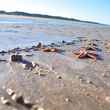
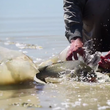

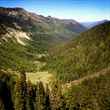



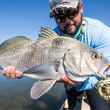









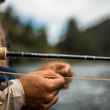
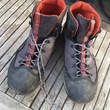






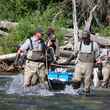
Comments